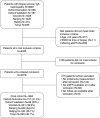Quantifying Duration of Proteinuria Remission and Association with Clinical Outcome in IgA Nephropathy
- PMID: 33514642
- PMCID: PMC8054888
- DOI: 10.1681/ASN.2020030349
Quantifying Duration of Proteinuria Remission and Association with Clinical Outcome in IgA Nephropathy
Abstract
Background: On the basis of findings of observational studies and a meta-analysis, proteinuria reduction has been proposed as a surrogate outcome in IgA nephropathy. How long a reduction in proteinuria needs to be maintained to mitigate the long-term risk of disease progression is unknown.
Methods: In this retrospective multiethnic cohort of adult patients with IgA nephropathy, we defined proteinuria remission as a ≥25% reduction in proteinuria from the peak value after biopsy, and an absolute reduction in proteinuria to <1 g/d. The exposure of interest was the total duration of first remission, treated as a time-varying covariate using longitudinal proteinuria measurements. We used time-dependent Cox proportional hazards regression models to quantify the association between the duration of remission and the primary outcome (ESKD or a 50% reduction in eGFR).
Results: During a median follow-up of 3.9 years, 274 of 1864 patients (14.7%) experienced the primary outcome. The relationship between duration of proteinuria remission and outcome was nonlinear. Each 3 months in sustained remission up to approximately 4 years was associated with an additional 9% reduction in the risk of disease progression (hazard ratio [HR], 0.91; 95% confidence interval [95% CI], 0.89 to 0.93). Thereafter, each additional 3 months in remission was associated with a smaller, nonsignificant risk reduction (HR, 0.99; 95% CI, 0.96 to 1.03). These findings were robust to multivariable adjustment and consistent across clinical and histologic subgroups.
Conclusions: Our findings support the use of proteinuria as a surrogate outcome in IgA nephropathy, but additionally demonstrate the value of quantifying the duration of proteinuria remission when estimating the risk of hard clinical endpoints.
Keywords: IgA nephropathy; end stage kidney disease; epidemiology and outcomes; glomerular disease; proteinuria; renal function decline; renal pathology.
Copyright © 2021 by the American Society of Nephrology.
Figures






References
-
- McGrogan A, Franssen CFM, de Vries CS: The incidence of primary glomerulonephritis worldwide: A systematic review of the literature. Nephrol Dial Transplant 26: 414–430, 2011 - PubMed
-
- Cattran DC, Feehally J, Cook HT, Liu ZH, Fervenza FC, Mezzano SA, et al. .: Kidney disease: Improving global outcomes (KDIGO) glomerulonephritis work group. KDIGO clinical practice guideline for glomerulonephritis. Kidney Int Suppl 2: 139–274, 2012
-
- Leaf DE, Appel GB, Radhakrishnan J: Glomerular disease: Why is there a dearth of high quality clinical trials? Kidney Int 78: 337–342, 2010. - PubMed
-
- Le W, Liang S, Hu Y, Deng K, Bao H, Zeng C, et al. .: Long-term renal survival and related risk factors in patients with IgA nephropathy: Results from a cohort of 1155 cases in a Chinese adult population. Nephrol Dial Transplant 27: 1479–1485, 2012 - PubMed
-
- Reich HN, Troyanov S, Scholey JW, Cattran DC; Toronto Glomerulonephritis Registry: Remission of proteinuria improves prognosis in IgA nephropathy. J Am Soc Nephrol 18: 3177–3183, 2007 - PubMed
Publication types
MeSH terms
Grants and funding
LinkOut - more resources
Full Text Sources
Other Literature Sources
Medical
Research Materials
Miscellaneous

